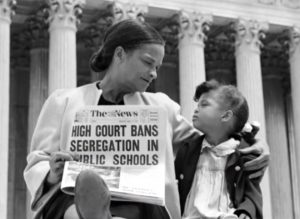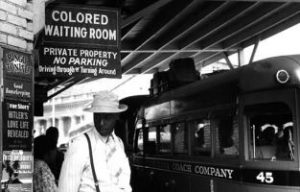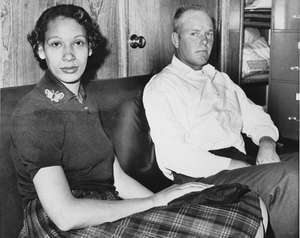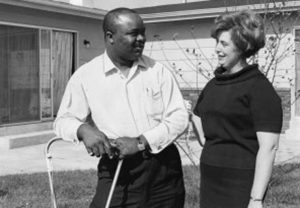Brown v. Board of Education (1954)

This source was found on the Library of Congress website within the category of Supreme Court cases, in particular, the Warren Court. Decided on May 17, 1954, Brown v. Board of Education of Topeka answered the question of the violation of the Equal Protection clause in the 14thAmendment as in a multitude of state individuals spoke up regarding the denial of African Americans to public schools on the basis of race. This decision went directly against the Plessy v. Ferguson decision as in all the states it was used to deny relief. This case was directed towards the states legislature, courts, and schools as the Supreme court decided that such discrimination laws did violate the Equal Protections clause as segregation of the education system had detrimental effects upon the personal growth of African American children as described by the Chief justice Earl Warren. The ruling in 1954 was a large turn in the legal battle to end segregation in the United States.
Brown v. Board of Education of Topeka, 349 U.S. 294 (1955)

Found in the Library of Congress under the Warren Court is the Brown v. Board of Education of Topeka (2), decided on May 31st, 1955. The reasons behind this case are the courts’ intervention in Brown 1 as many of the States refused to implement to Brown 1 decision. The question surrounded the implementation and principles around Brown 1. Regarding this,s the court decided with a unanimous decision with the majority opinion given by Earl Warren when he said that the local school systems must be implemented by the Supreme Court. In particular that the schools must desegregate with full compliance with “Deliberate speed”. This case spoke directly to the education system and local governments as they could not ignore the order in Brown 1 to desegregate and must do so in a timely fashion. This fits the theme of segregation and desegregation in legal terms as it affirms the first decision and uses the power of the supreme court to enforce such rulings.
Boynton v. Virginia (1960)

In Supreme Court records under the Warren Court is the Boynton v. Virginia case which was decided on December 5th, 1960. The case revolved around an African American law student named Bruce Boynton that was traveling through states and at one bus station in Richmond he decided to sit at one of the segregated restaurants. When he refused to move, he was arrested. This raised the question of if the arrest violated the Interstate Commerce Act. Taken up by the Warren court it was decided with a 7-2 majority that the actions taken by Virginia were in violation of the Interstate commerce act. Hugo L. Black gave the majority opinion when he said that since the transportation carrier provides the service such conveniences such as the restaurant are included in the protections provided by the Interstate Commerce Act. This decision had the intended audience of both the state and transportation services as the state could not arrest a man of color for sitting at one of the restaurants, nor could the transportation service make them segregated. This fits in with the overall theme as it illustrated the removal of discriminatory practices in the area of interstate transportation through the legal process.
Loving v. Virginia (1967)

In accordance with the Supreme Court archives specifically, the Harlan Court, the Loving v. Virginia case resides which was decided on June 12th, 1967. The case came into being when in 1958 Mildred Jeter an African American married Richard Loving a Whiteman and later moved to Virginia. This act broke the anti-miscegenation statute resulting in sentencing of one year which would be revoked if they left the state. The Supreme Court had the responsibility of deciding this statute violated the 14thamendment equal protection clause. With a unanimous decision, the court sided in favor of loving and with a majority opinion was given by Earl Warren said that the decision to marry someone regardless of race rested with the individual, not the state. This decision affected all Americans, but more importantly the state governments as they were proven to have no right to interfere in the marriage of individual on the bases of race. While allowing for all individuals to have such abilities. This supports the theme of the legal side of both discrimination and its dismantlement.
Jones v. Alfred H. Mayer Co. (1968)

Within the Judicial Archives of the Supreme Court of the Warren, Court is the Jones v. Alfred H. Mayer Company case, decided on June 17th, 1968. The case revolves around a real estate company in St. Louis that refused to sell him a home in a town on the basis of him being African American, this being an extension of Redlining. In a 7-2 decision that such actions are illegal. In particular cited Section 1982 of the Congressional act and the 13thamendment. In the hopes of ensuring racial equality this was decided and effects all Americans as real estate agencies couldn’t discriminate on the basis of race, nor could individuals in a community make deals to ensure the prevention of racial diversity. The only two no votes came from judges Harlan and White. This source fits in with the theme as it describes the legal dismantlement of discriminatory/segregation laws within the United States to contrast the discriminatory laws emplaced.
Griggs v. Duke Power Co. (1971)

Found in the Judicial Archives of the Supreme Court, in particular, the Burger Court, deciding the Griggs v. Duke Power company on March 8th, 1971. The case came to be because of an African American worker named Griggs challenged his employer due to the practices regarding aptitude tests in addition to higher education to prevent the transfer to lower paying jobs. In particular the violation of the 1964 Civil Rights Act. The question the court desired to answer was the company’s actions in respect to the Civil Rights Act of 1964, in particular, Title VII. The Burger Court decided in favor of Griggs in that Duke’s standard prevented African Americans, in particular, to advance into higher paying departments in the company and the Title VII desired to achieve equality in the workforce. This decision was directed towards employers and companies and it sought to prevent discriminatory practices in the workforce. This relates to the overall theme as it speaks to the legal dismantlement of segregation in the United States, in particular, that of workplace discrimination.
